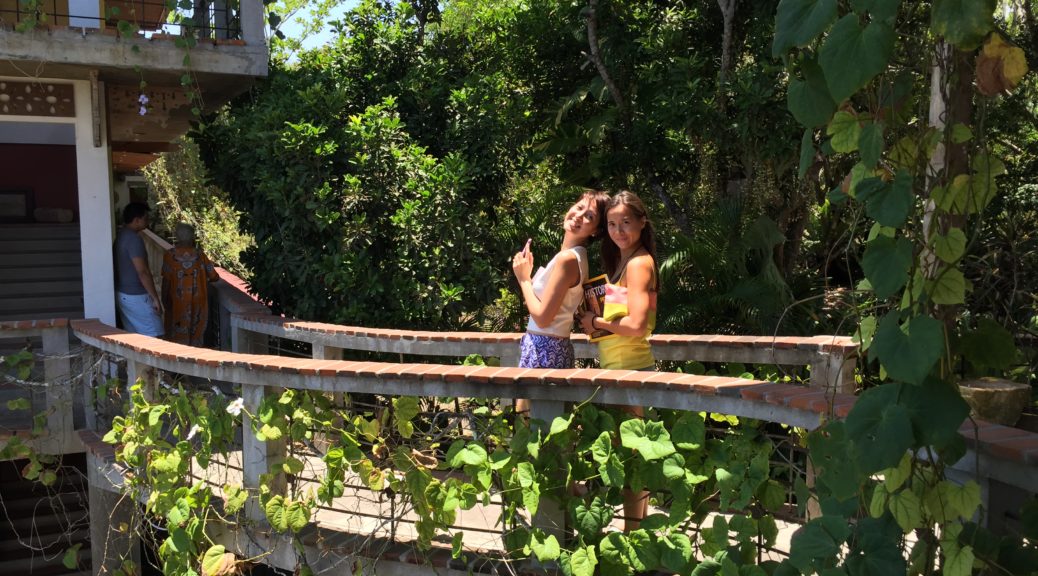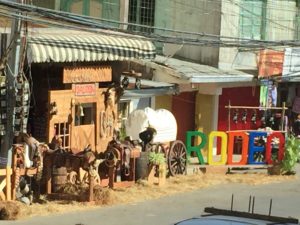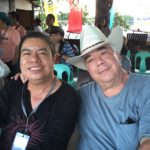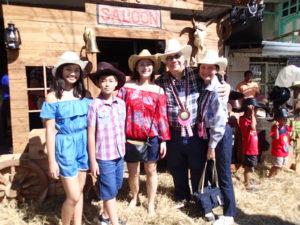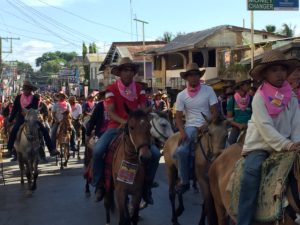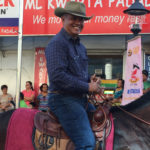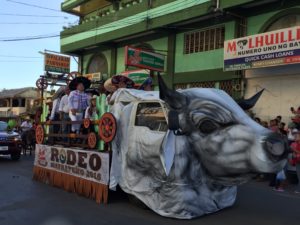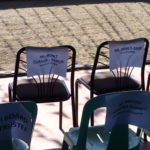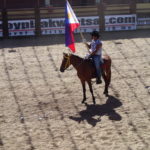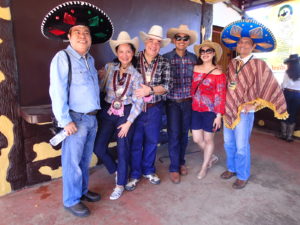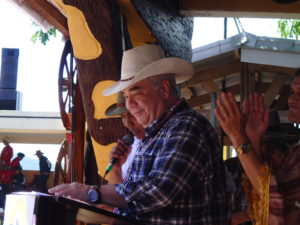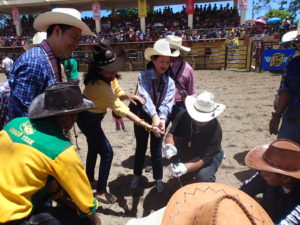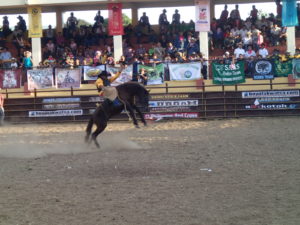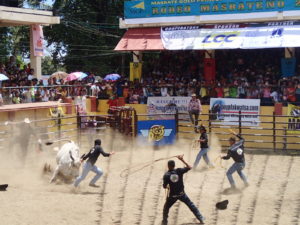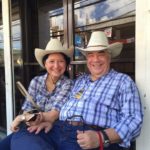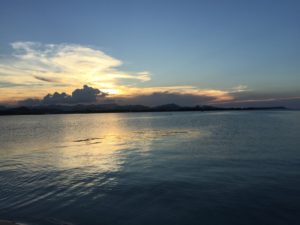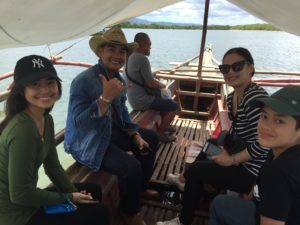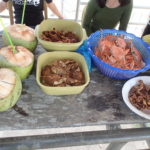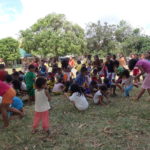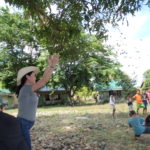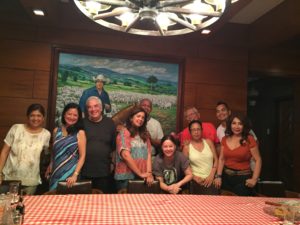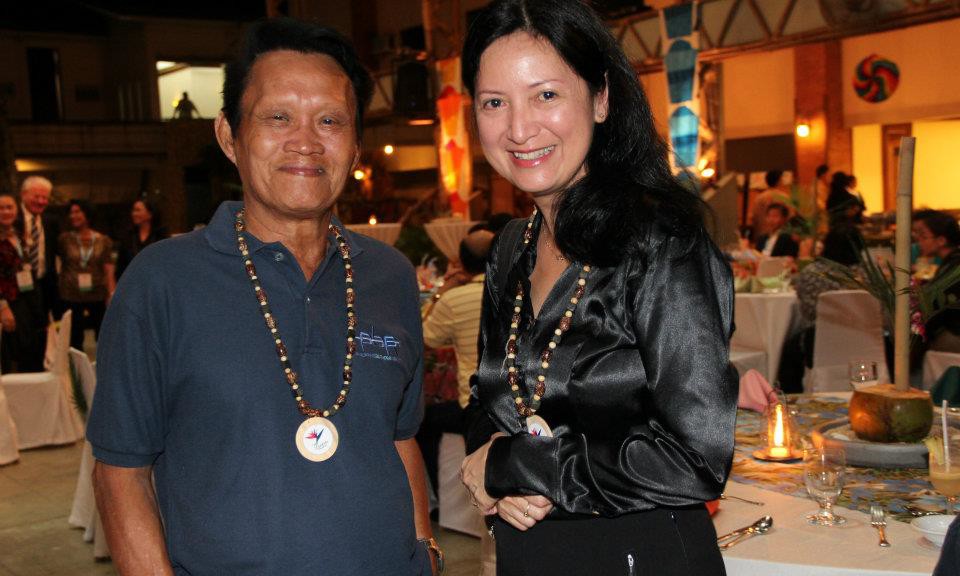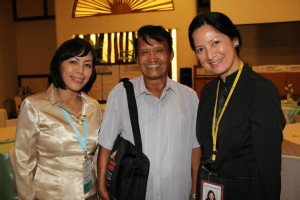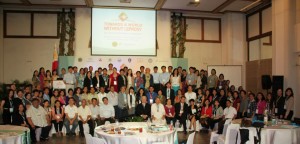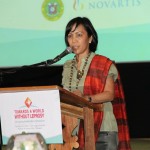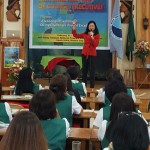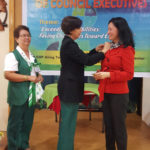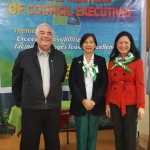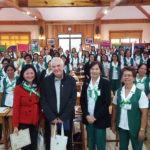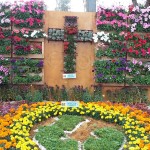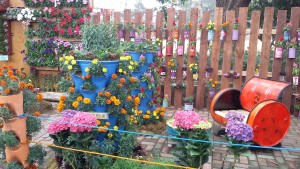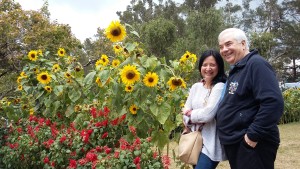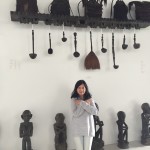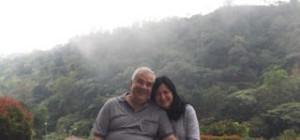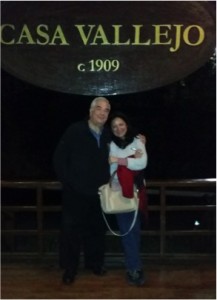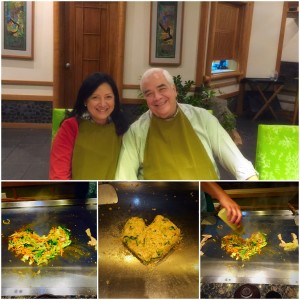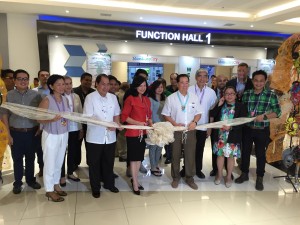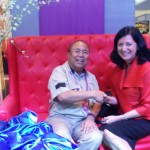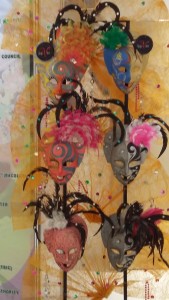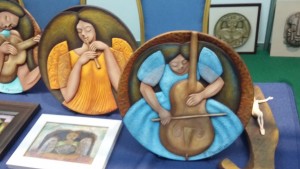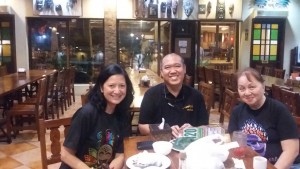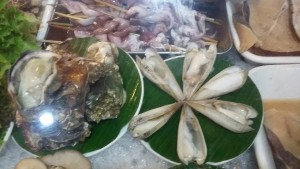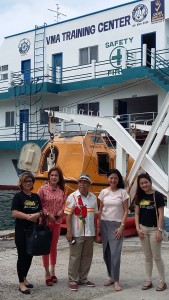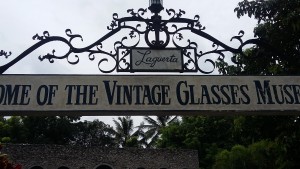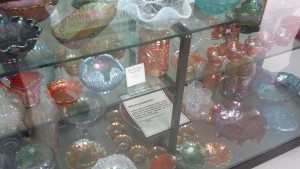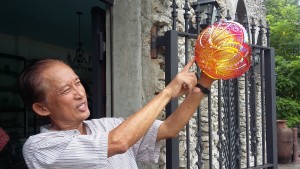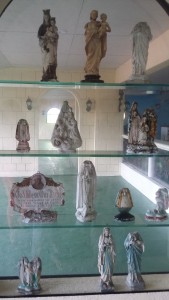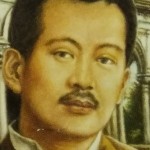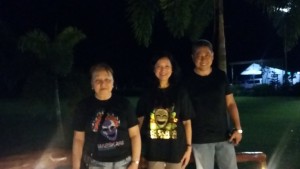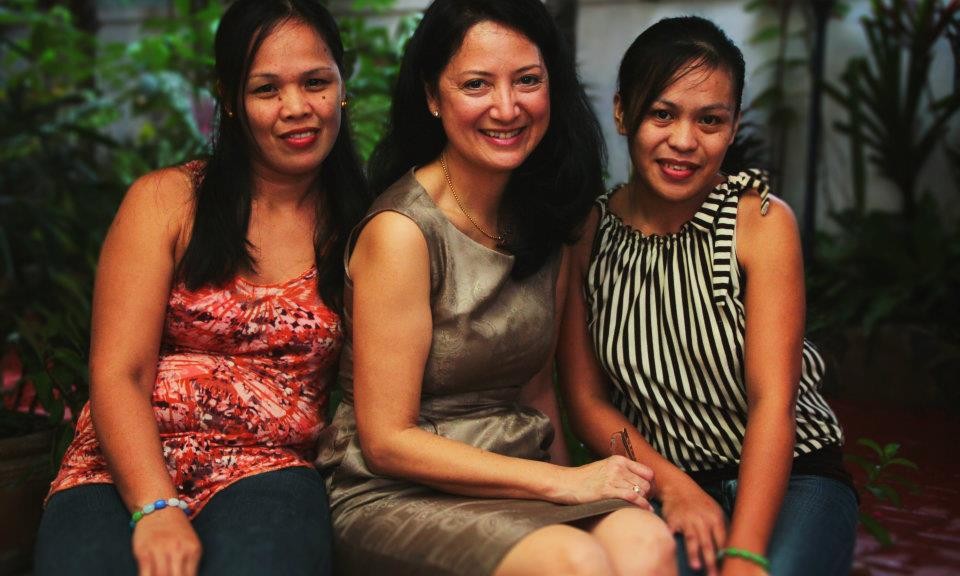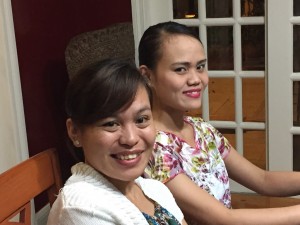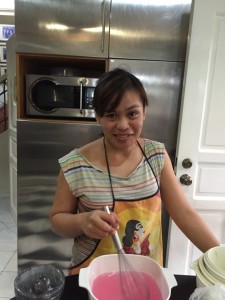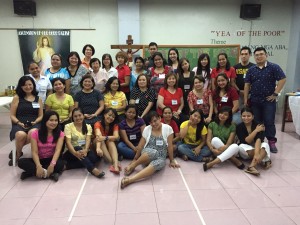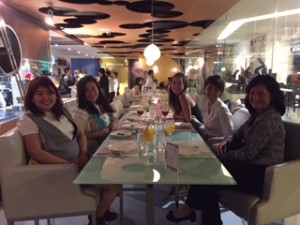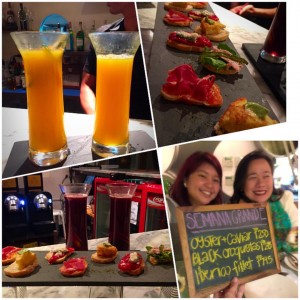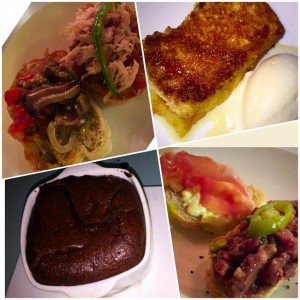The moment we arrived at Amarela and wooden steps were put to help us alight the van, I knew we were in for some serious pampering. And we were not disappointed.
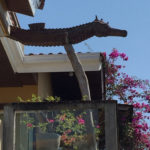
Everywhere I looked there was something interesting that caught my eye. It seemed a magical place where artists, sculptors and artisans were given free reign to create and do as they please. Whimsical creatures were carved on posts and repurposed old wood. Animals, birds, people, flowers, sea creatures were released from bondage in discarded tree branches, trunks and roots.
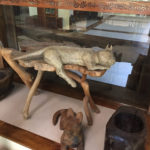 Here was a tarsier, its big torchlight eyes oggling at me. There was a cat lazily reclining on a bench, a dog by its side. A newborn babe with its umbilical cord still connected to his spent mother was carved out of a huge root. A child nested contentedly in her mother’s warm embrace hung on the wall. A carabao seat served as a swing by the main entrance. Serving as a downspout, a huge wooden seahorse thrust its neck out on the balcony like a gargoyle, seeming to lunge out into the waters.
Here was a tarsier, its big torchlight eyes oggling at me. There was a cat lazily reclining on a bench, a dog by its side. A newborn babe with its umbilical cord still connected to his spent mother was carved out of a huge root. A child nested contentedly in her mother’s warm embrace hung on the wall. A carabao seat served as a swing by the main entrance. Serving as a downspout, a huge wooden seahorse thrust its neck out on the balcony like a gargoyle, seeming to lunge out into the waters.
Old Bohol is Amarela’s theme, according to its owner, Atty. Lucas “Doy” Nunag whom I met the next day. He wanted to showcase Bohol’s unique culture, incorporating woodwork and woven textures into the place.
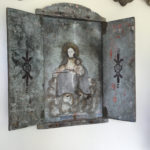
Gracing the wall along the stairs were “urnas” or personal saints, some done as triptychs, or three panelled paintings that were hinged together and could be closed. Doy said he wanted to revive this lost art, and encouraged local artists to paint them. Prints and paintings of scenes from yesteryears lined the walls.
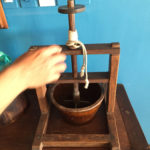
Doy had a collection of antique kitchen utensils and equipment, including a large shell as nutcracker and a paddle board for mixing dough. He also had an antique telephone, the kind that hangs from the wall.
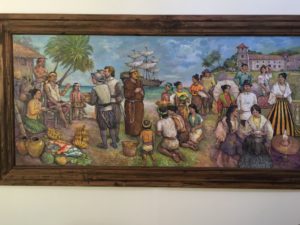
Giving me a quick tour of the place, Doy pointed out several paintings that were done by Hermoginia “Nene” Borja-Lungay, an 85-year old Boholana who had studied under Amorsolo and was a contemporary of Joya and Abueva. Using her gift of art, Nene is a master storyteller. In Amarela’s museum was a painting that showed three scenes flowing into each other: first on the left is a friendly encounter between the Spanish conquistadores bearing gifts and Datu Sikatuna, then in the canter is a Spanish priest preaching to natives with the galleon anchored out at sea visible behind him, and then to the right is a scene of Filipinas dressed in Maria Claras apparently coming from a church. What an ingenious way of portraying the start of Catholicism in the Philippines!
Ravenous from the trip, we settled in the dining room with a breathtaking view of coconut treetops, lush greenery, beautifully landscaped gardens, and the brilliant sea. Brunch was filling and delicious, and the staff solicitous.  Exhausted, we retired to our rooms for siesta. The air-conditioned rooms were spacious and bright, the beds comfortable and inviting. I loved the little design accents scattered around the room.
Exhausted, we retired to our rooms for siesta. The air-conditioned rooms were spacious and bright, the beds comfortable and inviting. I loved the little design accents scattered around the room.
The first night, Niccolo developed a high fever. Feeling light headed and wretched, he asked if we could bring him to the hospital. I approached Chef Nick Matias who quickly arranged for transportation to bring us to the Tagbilaran Community Hospital. Upon reading his test results, the doctor said it might be dengue, but it was too early to tell. He sent us off with a prescription for meds and instructions for Niccolo to rest and have lots of fluids. Learning that my 81-year old mother was sharing the room with us, the doctor recommended we keep her and Niccolo apart as she might catch what he had.
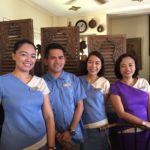
Luckily, the resort had one last room free which we quickly took. When the staff learned about what happened the next day, they searched for some tawa-tawa and made an herbal tea for Niccolo to take. What a thoughtful gesture!
We decided to stay in the resort on Good Friday. Ramon, Cara’s friend, arrived from Mindanao to take photos of Cara’s new bikini line for DiwataSwimwear.com. I took to writing, Dada to watching her Spanish telenovelas, Bea to reading by the beach, and Niccolo to resting in his room. Cara came back from her photoshoot giggling, looking like Princess Leia from Star Wars.

She was wearing a yellow towel which Ramon had fashioned into a headgear that could serve as a travel head pillow. In stitches, we took turns wearing his invention. In the afternoon, we gathered to pray the “Siete Palabras” in a quiet little room to the side of Amarela’s art museum.
That night, we broke our fast and went to Giuseppi Pizzeria and Sicilian Roast on the recommendation of Ramon and Cara who had visited it before. We enjoyed a repast of pizza Siciliana, pizza quattro formaggi, rigatoni arabiata, and tagliolini limone e gamberi, washed down with a Montepulciano red wine. To complete the meal we had warm apple pie with vanilla ice cream and a tortino de cioccolato.
Saturday morning, the girls and Ramon decided to go to Balicasag to visit the marine sanctuary, swim and snorkel. Niccolo continued his staycation to recuperate.
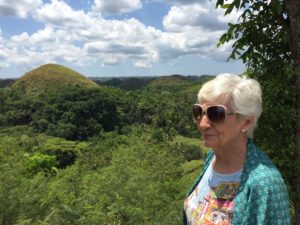
Meanwhile, Dada and I decided to go off sight seeing. The chocolate hills and tarsiers were on her bucket list, and she intended to tick them off her list. I, on the other hand, wanted to see the churches of Bohol. I’ve been feeling guilty about going off on vacation with the family instead of serving at the parish for the Easter triduum, and not going to church Thursday and Friday. I also wanted to visit some markets and see if there were any nice handicraft I could bring home.
 Our driver cum tour guide Rey was very accommodating and would point out places of interest, like the manmade mahogany forest and the Shiphaus, a hotel made to look like a ship along the roadside with nary a drop of water around. He also made sure we went to senior-friendly places so that Dada would not have a difficult time getting around. We went to the Philippine Tarsier Foundation in Corella because the trails were easier for senior trekking. At the Chocolate Hills, we took photos at the roundabout as Dada would not have been able to climb the 200+ steps to the top of the lookout. I had been there before, so after snapping a few photos, we left for the rest of our tour.
Our driver cum tour guide Rey was very accommodating and would point out places of interest, like the manmade mahogany forest and the Shiphaus, a hotel made to look like a ship along the roadside with nary a drop of water around. He also made sure we went to senior-friendly places so that Dada would not have a difficult time getting around. We went to the Philippine Tarsier Foundation in Corella because the trails were easier for senior trekking. At the Chocolate Hills, we took photos at the roundabout as Dada would not have been able to climb the 200+ steps to the top of the lookout. I had been there before, so after snapping a few photos, we left for the rest of our tour.
Do you want to see a python, Rey asked, and when I said yes, he promptly stopped at Bilar Hill Park & Restaurant in Casumbol, Bilar. Conquer your fears, the sign outside said. After paying the entrance ticket, we entered the dimly lit hut.

Inside, the first thing we saw was a large colorful bird perched on a branch. It looked menacing and squawked shrilly. I moved away quickly, but my intrepid mother approached the bird, a kalaw, and started to pet its head.

The bird appeared to be enjoying the petting it was receiving from my mom. Further on, I saw a bench where two women were posing gingerly with a large albino python draped across their laps. We were up next, and I was given the python to carry.

It seemed easy enough but quite heavy. Next up we were invited to enter the large cage where a dark Burmese python and another albino python slithered slowly. Don’t worry, the caretaker said, you’re safe; they have just eaten a chicken each. My stomach started to knot at the thought, and so we quickly posed for the souvenir photo and got out of there.

Rey then told us about the tug-of-war that was happening in Bohol. To seal their friendship on March 15, 1565, Bohol chieftain Sikatuna and Spanish explorer Miguel Lopez de Legazpi performed a blood compact or Sandugo, paving the way for the friendship between Filipinos and Spaniards and ultimately over 300 years of Spanish influence. This we learned in history books. The issue revolves around the actual site and date of the blood compact. Both Tagbilaran and Loay are laying claim that the Sandugo happened in their area. Loay’s marker says it happened on March 25, 1565 aboard the flagship San Pedro which was anchored off Hinawanan Bay, with the leaders drinking wine mixed with blood from cuts they had slashed on their chests. Tagbilaran’s version says the Sandugo happened ten days earlier on shore. Following the local custom, Datu Sikatuna and Lopez de Legazpi drew blood from a small cut on their arms, mixed this with wine, and drank from the goblet. The National Historical Commission upholds the version of Loay. Whichever version is true, the fact is Sandugo happened in Bohol and Rey says he is happy about this.
We stopped at Bohol’s famous heritage churches along the way: Saint James the Apostle parish church in Batuan, Paroquia del Senor San Isidro Labrador in Bilar, Church of San Pedro Apostol in Loboc, Holy Trinity Church in Loay, the Sta. Monica Church of Albuquerque, the Church of Our Lady of the Immaculate Concepcion in Baclayon, and the Assumption of Our Lady Church in Dauis. We were unable to do the Visita Iglesia on Holy Thursday, and so I was happy we completed the seven church visits on Holy Saturday. The 2013 earthquake that shook Bohol had sadly destroyed most of its churches turning them into rubble, and reconstruction was ongoing for most of them, making it difficult to enter.
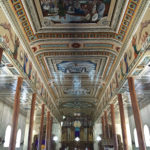
Of the seven churches we visited, Albuquerque seemed the only one to have survived the earthquake intact, perhaps because of the massive tree trunks that supported its roof. Looking up at the ceiling, I saw the beautiful religious paintings and trompe l’oeil that covered it. The altars were made of intricately carved dark wood, decorated with saints, angels, flowers, and sea shells.
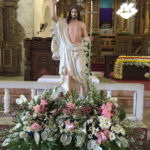
In front were two carrozas covered with colorful flowers — one of the risen Christ and the other of Mary – made ready for the salubong next day.
I felt saddest at Dauis, recalling how beautiful and vibrant the church was when I first visited it many years ago. It was empty now, with scaffolding covering the altar. Even the miraculous water well at the foot of the altar was covered. Outside, however, a temporary structure was set up, beautifully decorated with an angelic scene for the risen Christ.
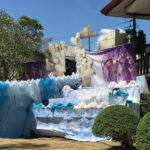
At the patio behind the church, several carrozas bearing saints were being readied: San Juan Evangelista, San Pedro, Santa Maria Magdalena, Santa Cleofe, Santa Jacobe, Santa Salome, among others. As it was well past 1pm, we decided to have lunch at the Dawis Café, and sample their Ube Kinampay Souffle. It was divine, well worth waiting for.
Despite the sad state of the heritage churches we visited, I observed parishioners busy cleaning the temporary structures built for the celebration of masses and decorating carriages for the processions that would take place for Easter. In some of them, parishioners were practicing for the Easter Vigil Mass and the salubong that would follow. I realized that no matter what hardship Filipinos go through, they keep their faith steadfastly burning. I felt humbled, suddenly missing the Lenten services I would serve at back in our parish.

Each afternoon Dada and I would walk along the beach, determined to complete our exercise goal of 10,000 steps per day target. We saw lovers embracing and frolicking on the beach, families sharing a meals, fisherfolk bringing their boats in, teenagers pitting their strength against each other in a tug-of-war, and children playing with their dogs. 
Arm in arm, we walked, sharing family stories of days long past, loves gained and lost, highs and lows, always ending with the realization that no matter how far you travel away from home, you come back to the people you love.
Saturday night, we decided to go to the Bohol Bee Farm. As there was no van available, we went by tricycle, while Bea, Cara and Ramon rode the motorbike. Bea had always regaled us with stories of her vacation there after college graduation, how serene it was, and how good the food was. She was spot on. We enjoyed the delicious dinner, starting with crisp cassava chips paired with a pesto vinaigrette and warm squash bread with a duo of honey mango and malunggay jam. The organic flower salad, clear vegetable soup, honeyed ribs, red rice, and fresh cassava lumpia were all delicious, as was the homemade malunggay ice-cream in cassava cone that I had after. Before leaving the Bee Farm, we visited their little store for some pasalubong, and bought some honey for home.
 Easter morning, we spent cooling ourselves in the pool, and enjoying each other’s company. At last, Niccolo left his room and joined us. Before we knew it, it was time to leave for the airport and return to Manila, but not before finally trying out the carabao swing by the entrance.
Easter morning, we spent cooling ourselves in the pool, and enjoying each other’s company. At last, Niccolo left his room and joined us. Before we knew it, it was time to leave for the airport and return to Manila, but not before finally trying out the carabao swing by the entrance.

As I swung back and forth, I thanked the Lord for the long weekend spent with family. Often, we are too busy with the daily grind of work and school commitments to spend time catching up. It was indeed a lovely time to bond, not just with my children but with my mom. Salamat, Lord!
